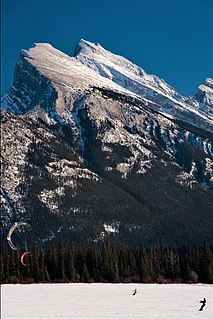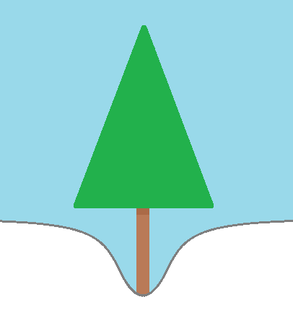 W
WSnowboarding is a recreational and competitive activity that involves descending a snow-covered slope while standing on a snowboard that is almost always attached to a rider's feet. It features in the Winter Olympic Games and Winter Paralympic Games.
 W
WSnowboarding is a recreational and competitive activity that involves descending a snow-covered slope while standing on a snowboard that is almost always attached to a rider's feet. It features in the Winter Olympic Games and Winter Paralympic Games.
 W
WWater ramps into oversized pools, ponds, or lakes are constructed as training locations for aerial skiing, mogul skiing, and snowboarding acrobatics events. Such structures typically comprise three sections: in-run, a kicker, and a water surface for landing. They permit the practice of new skills with reduced risk, as the impact of a water landing is less dangerous than a comparable impact on compacted snow.
 W
WThe Art of Flight is a Red Bull sponsored documentary film about snowboarding and a successor to That's It, That's All. Directed by Curt Morgan, it premiered in New York City on September 8, 2011, at the Beacon Theatre.
 W
WBackcountry snowboarding is snowboarding in a sparsely inhabited rural region over ungroomed and unmarked slopes or pistes in the backcountry, frequently amongst trees, usually in pursuit of fresh fallen snow, known as powder. Often, the land and the snow pack are not monitored, patrolled, or maintained. Fixed mechanical means of ascent such as ski lifts are typically not present, but alternative means such as splitboarding, hiking, snow shoeing and helicopters ("heliskiing") are sometimes used to reach the mountain's peak.
 W
WBig air is a sports discipline where the competitor rides a vehicle, such as a motocross motorcycle, a skateboard, a snowboard, or a pair of skis, down a hill or ramp and performs tricks after launching off very large jumps. In most versions, there is one large jump and therefore only one opportunity to perform a trick. It is an extreme version of slopestyle. Competitors perform complex tricks in the air, aiming to attain sizable height and distance as well, all while securing a clean landing. Many competitions also require the rider to do a specific trick to win the major prize.
 W
WBuckhorn Ski and Snowboard Club is located roughly 40 mi (64 km) north of Los Angeles in the Angeles National Forest. The U.S. Department of Agriculture owns the land and the United States Forest Service administers the area. It is a cooperative club with nominal dues but all members are expected to contribute time to maintenance.
 W
WThe Canadian Association of Snowboard Instructors (CASI) is Canada's national professional snowboard teaching organisation.
 W
WChad's Gap is a 120-foot (37 m) backcountry gap located in the Wasatch Mountains, approximately 0.6 miles (0.97 km) northeast of Alta Ski Area, in northern Utah, United States. One version of the structure's discovery has it that Chad Zurinskas, a local Utah resident after whom the gap was purportedly named, discovered it as a gap between two piles of mine tailings in 1999 and arranged with filmmaker Kris Ostness to make the first successful jump. The first successful jump was done by Candide Thovex.
 W
WA dry ski slope or artificial ski slope is a ski slope that mimics the attributes of snow using materials that are stable at room temperature, to enable people to ski, snowboard or snow tube in places where natural, snow-covered slopes are inconvenient or unavailable.
 W
WFirst Descent is a 2005 documentary film about snowboarding and its beginning in the 1980s.
 W
WA half-pipe is a structure used in gravity extreme sports such as snowboarding, skateboarding, skiing, freestyle BMX, skating and scooter riding.
 W
WPara-snowboarding classification is the classification system for para-snowboarding. The sport originally called Adaptive Snowboard is now practiced by hundreds of athletes around the world. The International Paralympic Committee (IPC) defines three classes: SB-LL for athletes with a physical impairment affecting one or both legs, and SB-UL for athletes with a physical impairment affecting one or both arms who compete standing. The sport made its official Winter Paralympic debut in the 2014 Winter Paralympics in Sochi, Russia.
 W
WThe Chevy Revolution Tour is a snowboarding competition series created in 2005 by U.S. Snowboarding to bridge the gap between grassroots level and elite snowboarding competitions. The sole purpose of the Chevy Revolution Tour is to help young riders make the jump to elite level competition and to progress the sport of snowboarding.
 W
WTravis Rice is an American professional snowboarder. He is #13 on Snowboarder magazine’s list of the 20 most influential snowboarders of the last 20 years. The 38-year-old has featured in more than twenty snowboarding films. Rice’s biggest claim to fame was when he arrived at Snowboarder magazine’s Superpark contest at Mammoth Mountain and launched a 'mammoth' of a backside rodeo across a 117-foot gap jump. He has been considered "the Paul Revere" of the big mountain freestyle movement. In 2013, Rice was named the best contemporary snowboarder in the world by Red Bull; Rice was also hailed as one of the greatest snowboarders of all time by numerous writers and publications.
 W
WSki geometry is the shape of the ski. Described in the direction of travel, the front of the ski, typically pointed or rounded, is the tip, the middle is the waist and the rear is the tail. Skis have four aspects that define their basic performance: length, width, sidecut and camber. Skis also differ in more minor ways to address certain niche roles. For instance, skis for moguls are much softer to absorb shocks from the quick and sharp turns of the moguls and skis for powder are much wider to provide more "float" in deeper, softer snow.
 W
WA ski helmet is a helmet specifically designed and constructed for winter sports. Use was rare until about 2000, but by about 2010 the great majority of skiers and snowboarders in the US and Europe wear helmets. Helmets are available in many styles, and typically consist of a hard plastic/resin shell with inner padding. Modern ski helmets may include many additional features such as vents, earmuffs, headphones, goggle mounts, and camera mounts.
 W
WA ski suit is a suit made to be worn over the rest of the clothes when skiing or snowboarding. A ski suit made for more casual winter wear outdoors may also be called a snowsuit [ˈsnoʊˌsut] and are often used by children as everyday outerwear in the winter season. Some suits are specifically made for snowboarders but most are used by either skiers or snowboarders regardless of the style.
 W
WSkis Rossignol S.A., or simply Rossignol, is a French manufacturer of alpine, snowboard, and Nordic equipment, as well as related outerwear and accessories, located in Isère, France. Rossignol was one of the first companies to produce plastic skis. The company also owns the brand Dynastar as well as LOOK. In 2005, Rossignol was bought by the boardsport equipment manufacturer Quiksilver for $560 million. In 2008, Quiksilver made a deal to sell Rossignol for $147 million to a former chief executive, Bruno Cercley.
 W
WSlopestyle is a winter sport in which athletes ski or snowboard down a course including a variety of obstacles including rails, jumps and other terrain park features. Points are scored for amplitude, originality and quality of tricks. The discipline has its roots in action sports like skateboarding and BMX and has very successfully crossed over into the snow sports worlds of skiing and snowboarding. Skiers use Twin-tip skis for their symmetry since they often go large portions of the course backward and for their balanced weight so as to not destabilize spins. Slopestyle tricks fall mainly into four categories: spins, grinds, grabs and flips, and most tricks done in competition are a combination of these.
 W
WSnowboards are boards where both feet are placed, and most times secured, to the same board, which are wider than skis, with the ability to glide on snow. Snowboards widths are between 6 and 12 inches or 15 to 30 centimeters. Snowboards are differentiated from monoskis by the stance of the user. In monoskiing, the user stands with feet inline with direction of travel, whereas in snowboarding, users stand with feet transverse to the longitude of the board. Users of such equipment may be referred to as snowboarders. Commercial snowboards generally require extra equipment such as bindings and special boots which help secure both feet of a snowboarder, who generally rides in an upright position. These types of boards are commonly used by people at ski hills or resorts for leisure, entertainment, and competitive purposes in the activity called snowboarding.
 W
WSnowboard cross, also known as boardercross, is a snowboard competition in which four to six competitors race down a course. Snowboard cross courses are typically quite narrow and include cambered turns, various types of jumps, berms, rollers, drops, steep and flat sections designed to challenge the riders' ability to stay in control while maintaining maximum speed. It is not uncommon for racers to collide with each other mid-race.
 W
WSnowkiting or kite skiing is an outdoor winter sport where people use kite power to glide on snow or ice. The skier uses a kite to give them power over large jumps. The sport is similar to water-based kiteboarding, but with the footwear used in snowboarding or skiing. The principles of using the kite are the same, but in different terrain. In the early days of snowkiting, foil kites were the most common type; nowadays many kiteboarders use inflatable kites. However, since 2013, newly developed racing foil kites seem to dominate speed races and expedition races, like Red Bull Ragnarok and the Vake mini-expedition race. Snowkiting differs from other alpine sports in that it is possible for the snowkiter to travel uphill and downhill with any wind direction. Like kiteboarding, snowkiting can be very hazardous and should be learned and practiced with care. Snowkiting is becoming increasingly popular in places often associated with skiing and snowboarding, such as Russia, Canada, Iceland, France, Switzerland, Austria, Norway, Sweden, Finland and the Northern and Central United States. The sport is becoming more diverse as adventurers use kites to travel great distances and sports enthusiasts push the boundaries of freestyle, big air, speed and back country exploration.
 W
WA snowskate is a hybrid of a skateboard and a snowboard, intended primarily to allow for skateboard-style tricks on the snow. There are many types depending on the brand or style of snowskate.
 W
WThe Snurfer was the predecessor of the snowboard. It was a monoski, ridden like a snowboard, but like a skateboard or surfboard, it had no binding. According to the 1966 patent by inventor Sherman Poppen, it was wider and shorter than a pair of skis, with an anti-skid foot rest. Like a sled, it had a lanyard attached to the front.
 W
WA splitboard is a snowboard that can be separated into two ski-like parts used with climbing skins to ascend slopes the same way alpine touring or telemark skis are. Similar to cross country skiing, splitboarding allows free heel movement and with skins attached to the bottom of the skis, provides uphill traction. The two halves can then be connected to form a regular snowboard for descent. Splitboarding culture often focuses on the idea of using your own power to access the backcountry usually on unmaintained trails.
 W
WA superpipe is a large halfpipe structure used in extreme sports such as snowboarding, freestyle skiing, skateboarding, scooters, freestyle BMX and vert skating.
 W
WDeveloped during the winter of 1996 by Martin and Erik Fey, the Teleboard consists of a long, narrow snowboard, or wide ski, with two free-heel telemark bindings arranged one in front of the other at a slight angle to the longitudinal axis. This is similar to a skwal which uses fixed-heel bindings mounted in line with each other.
 W
WA terrain park or snow park is an outdoor recreation area containing terrain that allows skiers, snowboarders and snowbikers to perform tricks. Terrain parks have their roots in skateparks and many of the features are common to both.
 W
WThe tindy is a snowboard grab in which the snowboarder grabs with his/her rear hand between the rear binding and the tail of the board on the toe edge. Its name is derived from a combination of the indy grab and the tail grab. The tindy grab is generally considered poor form in snowboarding.
 W
WA tree well, also known as a spruce trap, is the space around a tree under its branches that does not get the same amount of snow as the surrounding open space. This creates a void or area of loose snow below the branches and around the trunk that is dangerous to any hikers, snowshoers, skiers, and snowboarders who fall into them. If someone lands in such a well, often as a result of a fall, it can be too deep for them to climb up the surrounding loose snow before they are buried. Making the situation more dangerous, they often fall into the well head-first and as the result of an accident which could leave them injured or unconscious.
 W
WU.S. Snowboarding, the snowboarding arm of the United States Ski and Snowboard Association (USSA), is committed to the progression of snowboarding by providing athletic programs, services, and competitions for male and female athletes of all ages, coast-to-coast.
 W
WThe Vermont Ski and Snowboard Museum was established in Brandon, Vermont, United States, in 1988 as The Vermont Ski Museum, but was moved to Stowe in 2000 and opened to the public in its current location in 2002. In 2011 the word snowboarding was added to the museum's name. Currently the museum changes exhibits annually, with the exception of the Hall of Fame.
 W
WThe World Ski & Snowboard Festival (WSSF) is an annual celebration of snowsports, music, arts and mountain culture. The Festival is held each April in Whistler, British Columbia, Canada and has been recognized as the largest annual winter sports and music festival in North America. It has been called the snowsport industry's version of Burning Man.